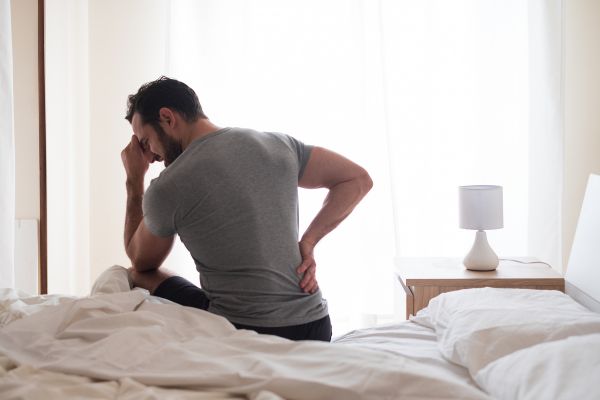If you’ve ever tossed and turned at night, trying to find that one perfect position that doesn’t make your back scream in protest, you’re not alone. Back pain is one of the most common issues people deal with, and let’s be real—it doesn’t magically disappear when you climb into bed. The truth is, your mattress can make all the difference between waking up refreshed or dragging yourself out of bed feeling like you lost a wrestling match. That’s why finding the best mattress for back pain isn’t just about comfort—it’s about your overall health, energy, and quality of life.
Why Your Mattress Matters for Back Pain
Think about it: you spend around a third of your life sleeping. If your mattress doesn’t support your spine properly, it’s basically like training your body to be out of alignment for hours every night. Over time, that adds up—tight muscles, stiff joints, and mornings where even reaching for your coffee feels like a workout. The thing is, the best mattress for back pain isn’t one-size-fits-all. It depends on how you sleep, your body type, and even personal preferences like firmness.
Firmness Levels: The Great Debate
When people start searching for the best mattress for back pain, the first question that pops up is usually about firmness. Some swear by firm beds, while others claim a softer feel is the way to go. So, what’s the deal?
Generally, medium-firm mattresses strike the sweet spot. They’re supportive enough to keep your spine aligned but cushioned enough to prevent pressure points. Too soft, and your hips and shoulders sink, throwing your spine out of balance. Too hard, and you end up with sore joints. Medium-firm is often the Goldilocks zone for back pain relief.
Memory Foam vs. Hybrid vs. Latex
Alright, let’s break down the main contenders:
Memory Foam
This material is known for its body-hugging feel. It molds around you, relieving pressure and keeping the spine neutral. If you’re a side sleeper with back pain, memory foam can feel like a hug for your body. The downside? It can trap heat, though many newer models add cooling tech.
Hybrid
Hybrids combine the best of both worlds: supportive coils underneath with a comfort layer of foam or latex on top. They offer the bounce of an innerspring with the contouring of foam. For back pain sufferers, hybrids are often the safest bet because they balance support and comfort really well.
Latex
Natural latex is durable, supportive, and naturally cooling. It’s more responsive than memory foam, so you won’t feel like you’re sinking. If you want something eco-friendly and supportive, latex mattresses are a solid option. They tend to be pricier, but they can last a long time.
Sleeping Positions and Back Pain
Here’s where things get personal. The best mattress for back pain also depends on how you sleep.
If you’re a back sleeper, you’ll want something that supports the natural curve of your spine—again, medium-firm is usually ideal. Too soft and your lower back sinks; too firm and your shoulders and hips feel strained.
For side sleepers, pressure points are the main issue. Look for something with cushioning around the shoulders and hips. A memory foam or hybrid with a plush top layer often works well.
Stomach sleepers (yes, I see you) usually need firmer support to keep the hips from dipping. Honestly, stomach sleeping isn’t the best for back pain, but if you can’t quit it, go with something firmer to keep alignment in check.
Signs Your Mattress is Making Back Pain Worse
Not sure if your mattress is the culprit? Here are a few red flags:
- You wake up with stiffness or soreness in your back.
- The middle of your bed sags like a hammock.
- You sleep better in hotels or on the couch than in your own bed.
- Your mattress is older than seven or eight years (yep, it’s probably time).
If any of these sound familiar, chances are your mattress is adding fuel to the fire.
Features to Look for in the Best Mattress for Back Pain
When shopping, don’t just focus on brand names or flashy marketing. Pay attention to the details that actually matter for your back:
- Zoned Support: Some mattresses are firmer in the middle and softer at the ends, giving your lower back extra support.
- Edge Support: A mattress that collapses at the edges isn’t just annoying—it’s a sign of weak support overall.
- Cooling Features: Heat can make back pain worse. Cooling gel, breathable covers, or latex materials help keep things comfortable.
- Trial Periods: Let’s be real, you won’t know if a mattress helps your back until you’ve slept on it for a while. A good return policy is essential.
Lifestyle Habits That Work With Your Mattress
Here’s the thing: even the best mattress for back pain won’t do all the work. Pairing your mattress with good habits makes a huge difference. Stretching before bed, maintaining good posture during the day, and using the right pillow can all enhance how supportive your mattress feels. And yes, staying active matters—stronger core muscles mean less strain on your back while you sleep.
Final Thoughts: Finding What Works for You
At the end of the day, the best mattress for back pain is the one that fits your body and sleep style. There’s no universal “perfect mattress,” no matter what ads promise. What really matters is support, comfort, and how your body feels in the morning. If you wake up with less stiffness and more energy, that’s your answer.
So, don’t settle for just any mattress. Do your homework, test a few, and remember—this is an investment in your health, not just a piece of furniture. Sleep should feel restorative, not like a nightly battle with your spine. The right mattress can change the way you wake up, move through your day, and honestly, how you live your life.

